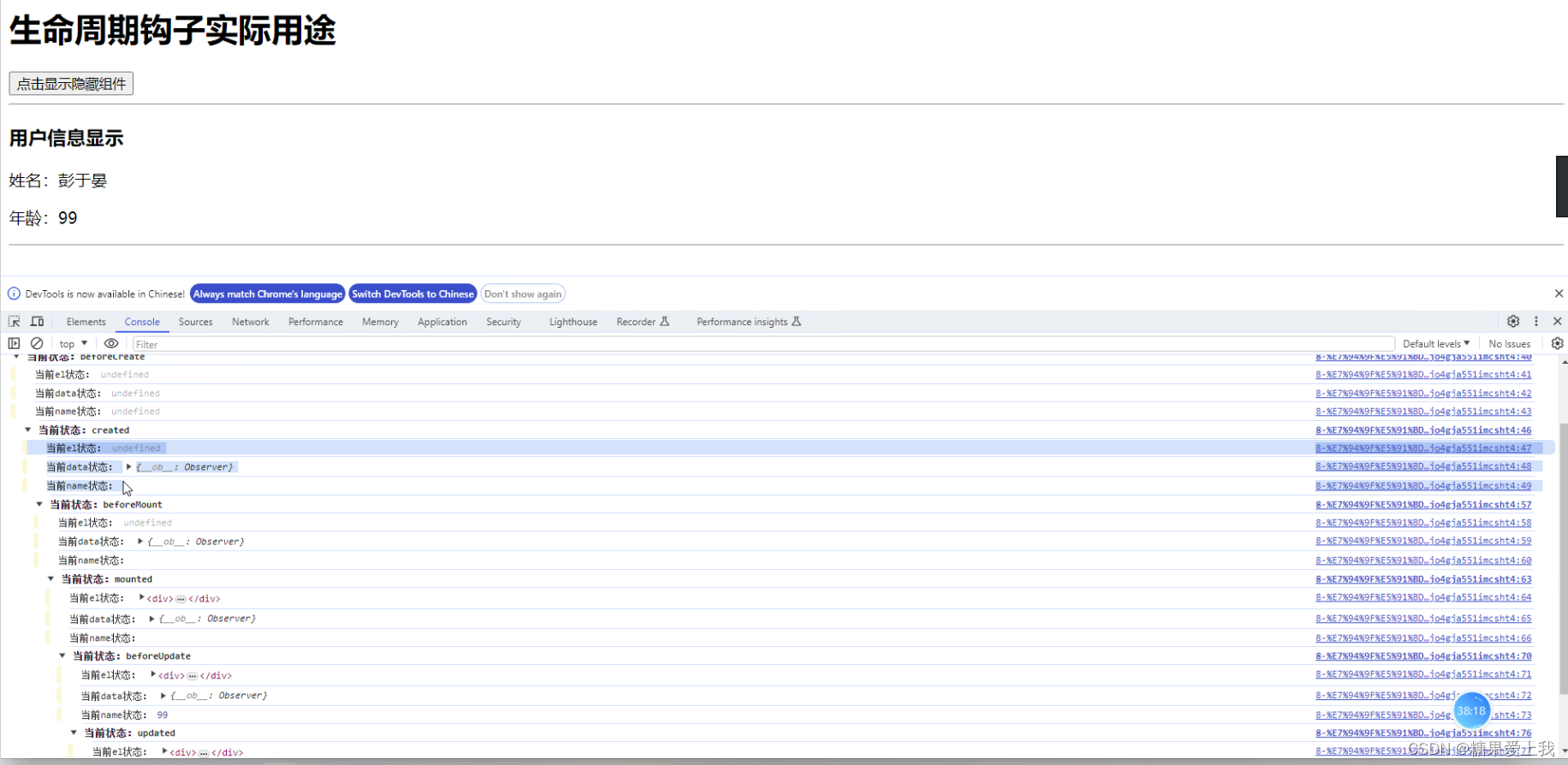vue知识-04
计算属性computed
注意:
????????1、计算属性是基于它们的依赖进行缓存的? ? ??
? ? ? ? 2、计算属性只有在它的相关依赖发生改变时才会重新求值
????????3、计算属性就像Python中的property,可以把方法/函数伪装成属性? ? ? ? 4、computed: { ... }
????????5、计算属性必须要有返回值
基本使用:
<body> <div id="app"> <h1>普通函数---其他数据变化---》函数会重写计算</h1> 年龄:<input type="text" v-model="age"> 姓名:<input type="text" v-model="name"> {{getAge()}} <h1>计算属性</h1> 年龄:<input type="text" v-model="age1"> 姓名:<input type="text" v-model="name1"> <br> {{newAge}} <br> </div> </body> <script> var vm = new Vue({ el: '#app', data: { age: '', name: '', age1: '', name1: '', }, methods: { getAge() { console.log('我执行了') return Number(this.age) + 10 } }, computed: { newAge() { console.log('我执行了--计算属性') return Number(this.age1) + 20 } } }) </script> </html>首字母变大写:
<body> <div id="app"> <h1>首字母变大写</h1> <input type="text" v-model="name"> ---》{{newName}} </div> </body> <script> var vm = new Vue({ el: '#app', data: { name: '', }, methods: {}, computed: { newName() { return this.name.substring(0, 1).toUpperCase() + this.name.substring(1) } } }) </script>通过计算属性,重写过滤案例:
<body> <div id="app"> <h1>过滤案例</h1> <input type="text" v-model="search"> <ul> <li v-for="item in newDataList">{{item}}</li> </ul> </div> </body> <script> var vm = new Vue({ el: '#app', data: { search: '', dataList: ['a', 'at', 'atom', 'be', 'beyond', 'bee', 'c', 'cs', 'csrf'], }, computed:{ newDataList(){ return this.dataList.filter(item => item.indexOf(this.search) >= 0) } } }) </script>
监听属性watch
特点:只要属性发生变化,就会执行 函数
<body> <div id="app"> <h1>监听属性</h1> <button @click="ordering='id'">按id排序</button> <button @click="ordering='price'">按价格排序</button> </div> </body> <script> var vm = new Vue({ el: '#app', data: { ordering: '' }, watch: { ordering() { console.log('我变了,向后端发送请求') console.log(this.ordering) } } }) </script>
生命周期钩子
# vue 组件的生命周期钩子函数:
?? ?一个vue的组件,从创建开始到最后销毁会经历一些过程,每个过程都绑定了一个函数,当到这个过程的时候,这个函数就会执行
? ? 面向切面编程:AOP
# 8个生命周期钩子函数:
?? ?beforeCreate:组件创建之前实现这个:组件html,js--》html和js都是空的
? ? created:组件创建完成后:js就有值了,html还是空的 ?(向后端发送ajax请求)
? ? beforeMount:挂载模板之前,js有值,模板(html) 还是空的(向后端发送ajax请求)
? ? mounted:挂载完成:js有值,模板有值
? ? beforeUpdate:刷新之前执行:只要页面发送变化或js变量发生变化,就会触发它的执行
? ? updated:刷新之后执行
? ? beforeDestroy:被销毁之前执行 ?(资源清理性工作)
? ? destroyed:被销毁之后执行
# 实际用途:
????????1、页面加载完成,向后端发请求拿数据:写在create中
?????????2、组件中有定时任务,组件销毁,要销毁定时任务
# 补充:定时器和延时器:setTimeout( ()=>{ console.log('延时器,3s后执行') },3000) ? ?? setInterval(()=>{ console.log('每隔3s执行') },3000)
组件介绍Vue.component
注意:
? ? ? ? 1、组件是有模板,有js的 ,有方法的对象 ?
? ? ? ? 2、组件和组件之间的变量,模板都是隔离的
? ? ? ? 3、Vue.component( '组件名' {? })
? ? ? ? 4、使组件,直接根据组件名使用即可? ?<Child></Child>
? ? ? ? 5、data里是数据需写在return{ age:19,... }
?全局组件和局部组件:
? ? ? ? 全局组件:1、?定义:Vue.component('Child',{})
? ? ? ? ? ? ? ? ? ? ? ? ??2、使用,可以在任意位置使用? ?<Child></Child>
? ? ? ? 局部:1、定义:var vm = new Vue({})
? ? ? ? ? ? ? ? ? ?2、使用:只能用在被 当前组件管理的html(#app) 中,放在别的位置找不到
定义组件:
Vue.component('Child',{ template: ` <div> <h1>我是组件</h1> <button @click="haneleClick">点我看美女</button> <p>年龄是:{{ age }}</p> </div>`, data() { return { age: 19 } }, methods: { haneleClick() { alert('美女') } } })
局部组件和全局组件
全局组件:<Lqz> </Lqz>
// 1 定义全局组件 Vue.component('Lqz', { template: ` <div> <h1>{{ name }}</h1> <button @click="handleClick">点我换名字</button> </div>`, data() { return { name: 'lqz' } }, methods: { handleClick() { this.name = '彭于晏' } } })局部组件: 是定义在组件内部,只能在当前组件中使用? ??<Child></Child>
<script> // 全局组件 Vue.component('Child', { template: ` <div> <Lqz></Lqz> <Lqz></Lqz> <Lqz></Lqz> </div>`, // 局部组件 components: { Lqz: { template: ` <div> <h2>我是局部组件</h2> </div> `, data() { return {} }, methods: {}, }} }) var vm = new Vue({ el: '#app', data: {}, methods: { handleClick() { alert('美女') }},}) </script>
组件间通信之父传子
使用自定义属性实现父传子:
????????1、在父中定义变量 ?name='lqz'
????????2、在子组件上 写自定义属性 ?<Child :name="name"></Child>
? ? ? ? 3、在组件内部:props:['name'] ?# 可以接收多个
? ? ? ? 4、在子组件内部,就可以使用插值,使用这个变量
<body> <div id="app"> <h1>组件通信之父传子:自定义属性</h1> <p>父组件中得名字:{{name}}</p> <div style="background-color: pink"> <Child :name="name" yy="xx"></Child> </div> </div> </body> <script> // 子 Vue.component('Child', { template: ` <div> <h2>我是Child组件</h2> <h3>父组件传递给子组件的:{{ name }}=={{yy}}</h3> </div>`, data() { return {} }, props:['name','yy'] }) //父 var vm = new Vue({ el: '#app', data: { name:'lqz' }, }) </script>
组件间通信之子传父
2、
<body> <div id="app"> <h1>组件通信之子传父:自定义事件</h1> 子组件的值:{{p_name}} <div style="background-color: pink"> <Child @myevent="handleEvent"></Child> </div> </div> </body> <script> // 子 Vue.component('Child', { template: ` <div> <h2>我是Child组件</h2> <input type="text" v-model="name">-->{{ name }} <button @click="handleSend">传给父亲</button> </div>`, data() { return { name: '' } }, methods: { handleSend() { this.$emit('myevent',this.name) }} }) //父 var vm = new Vue({ el: '#app', data: { p_name: '' }, methods: { handleEvent(name) { // name 是 子组件中调用 this.$emit('myevent',this.name) 传过来的 // alert('美女') this.p_name=name // 把子组件中传入的,赋值给父组件的p_name变量 }}}) </script>
今日思维导图:
本文来自互联网用户投稿,该文观点仅代表作者本人,不代表本站立场。本站仅提供信息存储空间服务,不拥有所有权,不承担相关法律责任。 如若内容造成侵权/违法违规/事实不符,请联系我的编程经验分享网邮箱:chenni525@qq.com进行投诉反馈,一经查实,立即删除!
- Python教程
- 深入理解 MySQL 中的 HAVING 关键字和聚合函数
- Qt之QChar编码(1)
- MyBatis入门基础篇
- 用Python脚本实现FFmpeg批量转换
- openssl数据压缩
- 557. 反转字符串中的单词 III --力扣 --JAVA
- python之列表动态生成和重复数据处理
- 【手把手带你玩转MyBatis】源码篇:深度剖析插件机制的精妙设计
- 基于指针的程序设计(3)
- 【JaveWeb教程】(18) MySQL数据库开发之 MySQL数据库设计-DDL 如何查询、创建、使用、删除数据库数据表 详细代码示例讲解
- 一篇文章快速通关 Vuex(适合小白学习)
- ARM平台Linux系统设置SPI中断亲和性(中断cpu掩码设置)
- 免 费 搭 建 小程序商城,打造多商家入驻的b2b2c、o2o、直播带货商城
- 实现scan-to-map匹配,使用ICP的C++代码实现(1)


